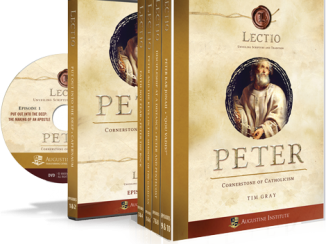 The Augustine Institute, partnering with Lighthouse Media and Ignatius Press, is excited to announce a brand new video-based study series: Lectio: Unveiling Scripture and Tradition. The first study in the series is entitled Peter: Cornerstone of Catholicism, and is presented by Dr. Tim Gray.
The Augustine Institute, partnering with Lighthouse Media and Ignatius Press, is excited to announce a brand new video-based study series: Lectio: Unveiling Scripture and Tradition. The first study in the series is entitled Peter: Cornerstone of Catholicism, and is presented by Dr. Tim Gray.
For those unfamiliar with Dr. Gray, he is a founding member of The Augustine Institute with an MA from Franciscan University of Steubenville, a ThM from Duke University, and a PhD from Catholic University of America. He has a specialization in Scripture, Lectio Divina, and the Gospel of Mark. Some books he has written include Praying Scripture for a Change; The Temple in the Gospel of Mark; and my personal favorite, Walking with God: A Journey Through the Bible. Before I get to my review of Peter: Cornerstone of Catholicism, here is a brief interview I was blessed to conduct with Dr. Gray.
Lectio Divina is a type of prayer that has become increasing popular in the past decade. For those of us unfamiliar with Lectio Divina, can you give us a brief summary of what it is?
Lectio sounds sophisticated, but it is simply the Latin word for “reading” and it is a very easy way to pray. Anyone can learn how to pray with Lectio Divina quickly, but also a form of prayer that is rich and allows one to grow into. Put simply, Lectio is learning to pray with Scripture, which allows you to hear God without being a mystic.
The Augustine Institute has produced several quality study programs lately, including Symbolon, True Strength, and True Beauty. Your latest one is entitled Lectio and begins by studying Peter. Of all the Biblical figures in the New Testament, why start with Peter?
In the Gospels Peter is mentioned more than all the other disciples combined! Peter’s personality jumps out of the Gospel narratives, and I think he is someone people find it easy to identify with. Peter is a compelling character, and as we read his story we realize that if Christ can call him, he can certainly call me too. What is more, Peter is close to Jesus, and the better we understand Peter the closer we can come to understanding Christ.
We see Peter in three key areas of the New Testament – the Gospels, the Acts of the Apostles, and the Epistles he is credited with authoring. About how much of this study comes from each Biblical area, and do you reference Catholic Traditions as well?
Our Lectio study on Peter dives into all four Gospels and Acts. In our participants guide, which is a rich 220 page book, we draw on Peter’s two epistles for many of the prayers, reflections and meditations. Throughout the videos and written materials we draw on the richness of the Catholic Tradition, from hymns to great art, as well as the Church’s Liturgy, so that the figure of Peter is seen from a multitude of beautiful facets.
What is the main message you hope people take away from this study when they are finished?
Peter is always with Jesus, and after someone goes through this study they will know why you can’t have Jesus without the Church. They will also learn and be inspired by the humble fisherman from Galilee, that God calls ordinary people to be extraordinary disciples.
What future titles can we expect in the Lectio series?
The next series is on the “Eucharist in the Old and New Testament,” by Dr. Brant Pitre—I’ve seen it and it is fabulous! Then Dr. Mary Healey is doing a series on “Acts of the Apostles & the New Evangelization.” And there will be a series on St. Paul as well, all coming within the next year.
Are there any other current or future projects you are working on that you would like to tell us about?
Presenting the Lectio study on Peter was such a terrific and inspiring experience for me, I have decided to start writing a book on Peter. I’m also giving a Bible Study on Paul that I hope will lead to a Lectio study on Paul later next year.
Now, for my review:
Peter: Cornerstone of Catholicism begins with Dr. Gray giving us a brief portrait of Peter. He refers to him as a common man and someone that we can relate to. He is not some great scholar or brilliant man, but was a simple fisherman who followed Jesus. He was a bit hot-headed and impetuous and almost always had his foot in his mouth, but he loved the Lord, despite his betrayal of Jesus at a time of weakness.
It is interesting to note that Peter is one of the most frequently mentioned people in the Gospels. He was part of the inner circle along with James and John, the head of the Apostles, and he was essentially Jesus' right hand man, as it seems almost everywhere Jesus is mentioned Peter is right there with Him.
The Bible Study is presented in a lecture format, like a professor teaching you. There are not breathtaking scenes, like Fr. Barron's programs, and while that might be a negative for some, it did not bother me at all. There are ten sessions in this Bible Study, which range from 30 to 50 minutes in length. The session titles are as follows:
- Put out Into the Deep: The Making of an Apostle
- Capernaum: Village of Coming Consolation
- Faith Not Fear: Walking in Trust
- Peter the Rock: The Primacy of Jesus
- Peter and the Keys: The Primacy the Church
- In the Shadow of the Galilean: Peter's Rising Leadership
- Discipleship at a Distance: Peter and the Passion of Christ
- Peter and Pentecost: The Transforming Power of the Holy Spirit
- Peter Bar Jonah: How Peter Came to Rome
- "Quo Vadis?": Peter's Way of the Cross
One could pick any of the above topics solely and have enough to reflect on to last a lifetime. Instead of giving a brief one-sentence synopsis of each lesson, I am just going to focus on Lesson Two: Capernaum.
One thing Dr. Gray pointed out that I never saw was that Jesus made Peter's house His headquarters. He also uses Mark's Gospel to point out all the references to Peter and Peter's headship of the Apostles from the very beginning. Simon Peter is the first (Mark 1:16) and last (Mark 16:8) disciple mentioned in the Gospel of Mark. This was a framing device used to attribute the primary source/witness of Mark's Gospel. Dr. Gray then goes on to explain how Mark was most likely written in Rome, while Mark was a disciple of Peter, making this essentially "Peter's Gospel."
But, back to the main point, why is Capernaum so significant? Apparently, Capernaum was the first part of the Holy Land that fell to the Assyrians in 732 B.C., thus giving Capernaum the nickname "Galilee of the Gentiles." We see that in Matthew 4:12-14, which explains the prophecy of Isaiah, and how the Light (Jesus) will shine on Capernaum again, and they will be the first to hear the Good News of Jesus. Mind blown! This was only a sampling of that lesson. There's still another two-thirds in that one lesson alone that I didn't talk about, but I just wanted to whet your appetite.
This is a top-notch Study Program from an A+ Catholic scholar. Dr. Gray does a nice job not only in presentation, but in his teaching. He somehow manages to make it both accessible for beginners and deep for the more learned. In addition to this DVD set, you also get a 200+ page study guide which includes outlines of each session, questions for group discussion, tips on how to incorporate Lectio Divina in your prayer routine, and guided reflections to use for individual study throughout the week.
For a limited time (until the end of 2014), if you buy one Study set, you get another Study Set free! That means you can have one for you, and give one as a gift to a friend or to your Church so that more people can benefit from it. Check out that sale here.
Lastly, I have included a preview video below, so you can really get a feel for the study.
[youtube_sc url="www.youtube.com/watch?v=bKc26EVJ9Uc"]
Be sure to check out our Book Notes archive.
Copyright 2014, Stuart Dunn
About the Author

Stuart Dunn
Stuart Dunn was born and raised in Mobile, AL and received a Bachelor of Arts in Psychology and a Master of Business Administration from the University of South Alabama. Stuart reviews all things Catholic including adult books, children’s books, Bible Study series, Catholic Courses, CDs, and DVDs in addition to board games at his blog Stuart’s Study at StuartsStudy.blogspot.com.



.png?width=1806&height=731&name=CatholicMom_hcfm_logo1_pos_871c_2728c%20(002).png)
Comments